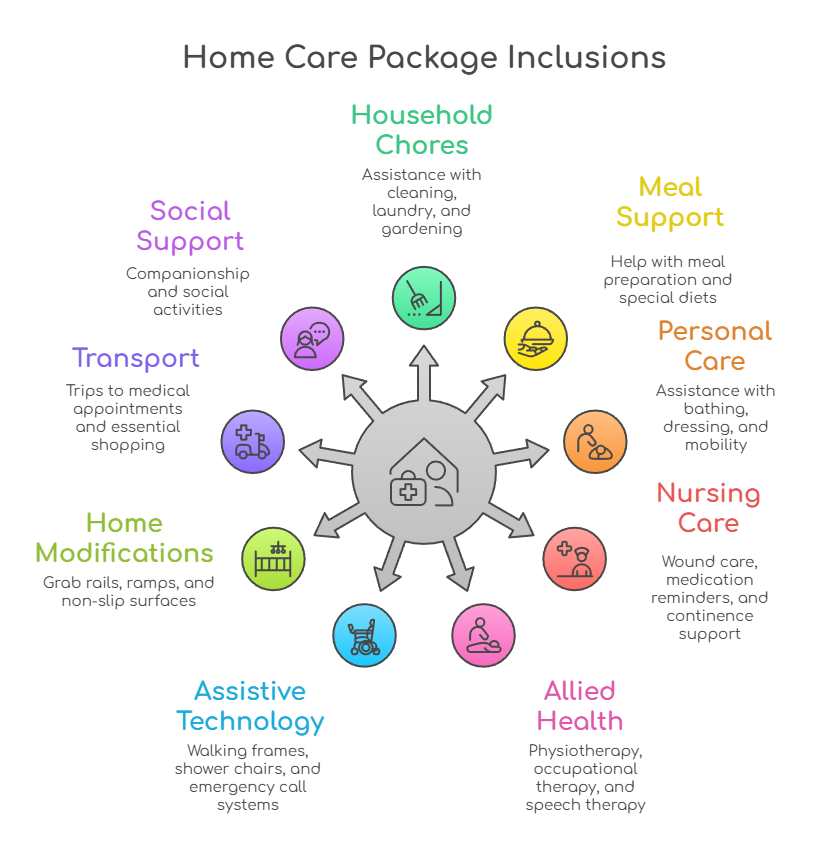Everything you need to know about HCP inclusions and exclusions
Learn what your Home Care Package does and does not cover in 2025, with clear guidelines to help you use your HCP funding correctly.
Author: Sensible Care

Your Home Care Package (HCP) covers only services directly linked to your age-related care needs. Everyday expenses or leisure activities do not fall under this coverage. Instead, your package funding applies to help with household chores, everyday tasks, and personal care services. However, bills, renovations, or medical costs covered elsewhere are not included.
A Home Care Package (HCP) funds services that directly support your care needs. These services may include personal care, help at home, allied health, and mobility equipment.
It does not cover everyday living costs like rent, groceries, or entertainment.
Knowing the difference between what's included and excluded helps you better manage your budget.
Bear in mind that the HCP program will transition to a new Support at Home system on 1 November 2025. This means that some rules will change, which may apply to HCP inclusions and exclusions.
Home Care Package inclusions
Your Home Care Package should cover services that directly address your aged care needs. These services may include:
- Help with household chores and everyday living activities - cleaning, laundry, changing bed linen, gardening, etc.
- Meal support - preparing meals, help with special diets, or meal services, help with feeding (if medically necessary), etc.
- Personal care - bathing, dressing, toileting, and help with mobility.
- Nursing care - wound care, medication help and reminders, and continence support.
- Allied health and clinical services - physiotherapy, occupational therapy, podiatry, and speech therapy.
- Assistive technology and aids - walking frames, bedside rails, shower chairs, emergency call systems linked to needs.
- Small home modifications - grab rails, ramps, and non-slip surfaces that are tied to safety and care goals.
- Transport related to care - trips to medical appointments, essential shopping, or approved social outings.
- Social support and community access - companionship, escorted outings, and social activities to reduce isolation.

Home Care Package exclusions
While Home Care Packages cover a wide range of services, some of them are off-limits, such as:
- Everyday living costs like utilities, mortgage, rent, rates, phone, and internet bills.
- Food and groceries. HCPs may fund meal preparation and delivery fees, but not the cost of food, except for enteral feeding prescribed for clinical need.
- Major home renovations or house purchases not directly needed for safety or care.
- General medical services and medicines funded by Medicare or the Pharmaceutical Benefits Scheme (PBS).
- Hospital and residential aged care fees covered by other programs.
- Lifestyle and entertainment expenses like holidays and leisure activities.
- Equipment for general use, such as TVs, computers, or phones, used for entertainment.
- Items for carers/families. The funding must benefit the care recipient, not pay for family utilities, costs, or non-recipient items.
- Anything not linked to assessed needs or approved in your care plan.

Examples by package level
The level of your Home Care Package affects how much funding you get, but not which services are covered.
Any HCP-funded service must:
- Address your assessed age-related care needs
- Be in your care plan, regardless of the level
These are the four Home Care Package levels:
- Level 1: Basic needs
- Level 2: Low care needs
- Level 3: Intermediate care needs
- Level 4: High care needs
The same categories can be funded at any level when justified by assessment and care plan. What this means in practice:
Even if your package "level" allows it, the provider must always check whether a service is justified based on your needs.
Special considerations
While the Home Care Package (HCP) rules are clear about what's included and excluded, there are exceptions where flexibility applies.
These are situations where a normally excluded item or service may be approved if it directly supports your assessed care needs and isn't funded elsewhere.
Your provider may approve an exception if all the following apply:
- The item or service is clearly linked to your ageing-related care needs.
- It helps you live safely and independently at home.
- It's not already funded by another government program (e.g., Medicare, PBS, NDIS).
- It offers a reasonable cost-benefit compared with similar supports.
- It's documented in your care plan with justification and evidence of need.
Common examples of approved exceptions
Some normally excluded items can be approved if your care plan justifies the expense.
Meal delivery services
May be covered if linked to assessed nutrition needs, where the recipient cannot shop or cook safely.
Home modifications
Minor safety-related changes (e.g., grab rails, ramps, slip-resistant flooring) are usually allowed, even though major renovations are not.
Technology and communication devices
Phones, tablets, and computers are usually excluded since they are general household items. However, you can get funding for personal monitoring technology or support to use communication aids. These aids must be clearly linked to your assessed needs and care goals.
Transport services
Home Care Packages may fund taxi vouchers for care‑related travel. For example, to medical appointments, essential shopping, and social inclusion. But public transport fares and private vehicle costs are excluded.
Cleaning or gardening above standard limits
Sometimes approved if a health condition prevents you from maintaining hygiene or safety standards.
Managing your package funds wisely
Knowing the rules is one thing, but making them work for you is another. Here's how to make sure you're using your Home Care Package budget correctly:
- Start with your care plan.
- Ask for documentation.
- Regularly review your usage.
- Negotiate smarter.
- Understand the transition to Support at Home.

First, make sure every service is justified in your plan. If you think something qualifies but isn't included, ask your provider to consider it under the exceptions rule.
Next, get written reasons when items are refused and keep records for clarity.
Reassess every six to 12 months or sooner if your health changes. Services you needed yesterday may no longer suit tomorrow.
If you see an excluded item you genuinely need (e.g. certain mobility aids), propose it and ask your provider to evaluate it under the framework.
Keep in mind that some HCP inclusions and exclusions may shift under the new program from 1 November 2025.
The impact of the Support at Home reform (starting 1 November 2025)
The Support at Home reform, launching on 1 November 2025, will directly affect how Home Care Package (HCP) inclusions and exclusions are defined and applied.
While the guiding principle remains — funding must support your assessed care needs — the new program will update how services are structured, priced, and approved.
Under Support at Home, the government plans to streamline existing programs into one simplified system. This includes Home Care Packages.
This will make it clearer which supports can be funded and reduce confusion about what counts as an inclusion or exclusion.
Key updates will include:
- Standardised service categories and pricing, providing greater consistency across providers.
- Simplified eligibility and assessment processes, helping you understand which services meet your needs.
- More flexibility and choice in how you use your funding, including the ability to select and change providers more easily.
- Revised fees and contributions, which may change how much you pay toward certain services.
Those with a Home Care Package should review what their package covers frequently. Stay updated on HCP inclusions and exclusions as the transition approaches.
Some services considered excluded today may become eligible under the new framework — and vice versa.
FAQ
Can I use package funds for internet, phone, or TV?
No, these are general costs, not care supports. They are excluded under standard rules.
Are there any grey areas or "exceptions"?
Yes, certain excluded items may be approved if they meet your assessed ageing-related care needs and can't be funded elsewhere.
What changes with Support at Home in late 2025?
The new program will change some rules, alter how services and contributions are categorised, and might add new options, but the final details aren't set yet.
If my provider refuses an item, can I appeal?
You can ask for their decision in writing and review it together. Use the Inclusions/Exclusions Framework (Part 9 of the provider manual) as guidance.
Understanding Home Care Package inclusions and exclusions with Sensible Care
Knowing exactly what your Home Care Package (HCP) covers, and what it doesn't, is essential to making the most of your funding.
At Sensible Care, we make understanding and managing your Home Care Package simple.
We will help you understand government rules, organise your care plan, and choose the most cost-effective support options.
Whether you're new to home care or reviewing your current package, we'll guide you through every step, making sure your funding is used wisely and in line with your goals.
Contact Sensible Care today to get clear, practical advice on how to maximise your Home Care Package and access the right care for your lifestyle.
Take the Next Step in Care
Download our Info Kit or speak to one of our friendly team members today.
Need Help Getting Started?
Reach out on your terms, pick a time that suits you and let’s talk about how we can help.
.webp)
.svg)


.webp)